 |

| ||||
 |
|||||
|
Email Ryan
Can't find it here?
|
BreathingPrinter Friendly Format
This Online Lesson is (c) 2000 , Ryan Fraser. All right reserved. NO COMMERCIAL DISTRIBUTION.
In all seriousness, breathing is perhaps one of the most crucial aspects to playing the saxophone, and often the least understood by most players, amateur or professional. The basis of your sound and your control on the instrument lies with your breathing technique. And breathing, no matter how long you have been working at it is a difficult skill to master. Stop and think about it for a moment. Can you describe how you breathe? Probably not. For most of us, breathing is not something that we routinely think about and analyse. More importantly, we don't often think of the aspects of our lifestyle often interfere with our ability to breath properly while playing.
So how do you breathe?There are a variety of muscles which help you to breathe. Most of us know about the diaphragm, which is a large, flat muscle which rests underneath the lungs and helps to push air in and out of your lungs. This acts very much like the bellows on a blacksmith's fire - the diaphragm is the "power" behind breathing. If you want to project, you've got to use it!The second set of muscles which help you to breathe are your inter-costal muscles. These are the muscles between your ribs. Like eating spare ribs? Well, I hate to break it to you, but spare ribs are nothing more than a pig's inter-costal muscles.
So how can you maximize your breathing power?
As I said, imagery is a wonderful thing. . . for most people, this image causes them to automatically breathe using full support from their diaphragm. Most adults are very shallow breathers - we tend to use just our inter-costal muscles to help us breathe. As a result, we breathe quite high up in the chest. You will find that breathing "like a tree" will help you to have maximum support. There are other ways to help you out. Place a belt snugly around your waist, so that when you inhale, you can feel it press gently against you, much like a weightlifting belt might work. This will remind you to have good support - if you have poor support, the belt will fall off!
|
||||||||||||||
|
|
|||||||||||||||
Website problems? Please email us!


